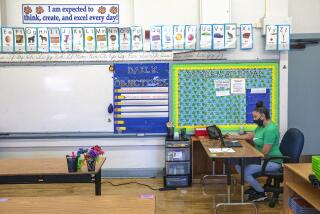Keeping It in View
- Share via
When her daughter hops on the computer, Kathy Corbin isn’t far behind.
The Corbins’ computer is in the family room, where Kathy and her husband, Dave, can keep an eye on their three children while cooking dinner.
“It works well in the family room because that’s where we spend the majority of our time,” Kathy Corbin said.
Although the home office remains the most common place for the family computer, a number of households prefer a more public place. But exactly where to put a computer is a dilemma many parents have yet to solve. About as many families keep PCs in a bedroom as in a recreation or family room, according to a UC Irvine study.
Child advocates encourage parents to keep the computer in social spaces where children can be monitored. Since families already spend much of their time together in such areas--many parents read to their children in the living room, for example--placing the computer in the open makes computing a family activity.
“It’s a more natural way to start your children’s experience with a computer as a social tool,” said Alan Simpson, spokesman for the National Assn. for the Education of Young Children.
Although younger children may need more parental supervision while on the computer, the family PC should be kept in a public place regardless of a child’s age, said Sandra Calverts, a professor of psychology at Georgetown University.
“You just don’t want your child to end up in a place where they are in over their heads,” she said.
The push for placing the PC in a family space is in response to Internet pornography, said Maria Papadakis, associate professor of urban affairs and planning and director of the Institute for the Social Assessment of Information Technology at Virginia Tech.
To protect children from seeing inappropriate material online, many child-advocacy groups urge parents to monitor their children’s computer usage more closely.
During the mid-1980s, when UC Irvine management professor Alladi Venkatesh began studying home computer usage, many families kept PCs in the bedroom.
A number of households have since moved the PC to other parts of the house: home office (29%), den or recreation room (16%), living or family room (15%) and kitchen (4%), according to studies done by the university’s National Outlook for Automation in the Home project.
The study found that 16% of households still store the computer in the bedroom.
“If you look at other technologies in the home, you can immediately designate a place [for them],” said Venkatesh, who directs the NOAH project. “Computers have not reached this stage.”
Only about one-third of households have special furniture for their computers and less than one-tenth have special furniture and a space configured specifically for the computer. One household may keep the computer on a desk while another keeps it on a coffee table and yet another puts it on the kitchen table.
“People are trying to negotiate their space in a way that makes sense in terms of their lifestyle,” said Venkatesh, associate director of the NOAH project.
Most families must consider how the space around the computer will affect its use, and vice versa. Those with children who use the computer for homework may keep it in an area away from a television to avoid study distractions.
Practical issues, such as the location of electrical outlets or telephone jacks, also dictate where a computer is placed.
Kimberly Deans of Alisa Viejo set up the family computer in a bedroom walk-in closet. With four children, there isn’t enough room in the house for a separate office or den.
The configuration has worked well, though.”They have to go through me before they actually get through there,” she said.
*
Christine Frey covers personal technology. She can be reached at christine.frey@latimes.com.




